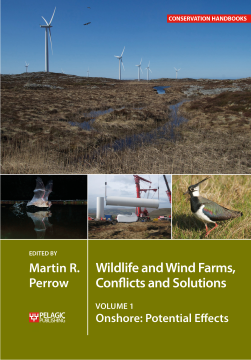
Additional Information
Book Details
Abstract
Wind farms are an essential component of global renewable energy policy and the action to limit the effects of climate change. There is, however, considerable concern over the impacts of wind farms on wildlife, leading to a wide range of research and monitoring studies, a growing body of literature and several international conferences on the topic.
This unique multi-volume work provides a comprehensive overview of the interactions between wind farms and wildlife.
Volume 1 documents the current knowledge of the potential impacts upon wildlife during both construction and operation. An introductory chapter on the nature of wind farms and the impact assessment process is followed by a series of in-depth chapters documenting effects on climatic conditions, vegetation, terrestrial invertebrates, aquatic invertebrates and fish, reptiles and amphibians, birds, bats and terrestrial mammals. A synopsis of the known and potential effects of wind farms upon wildlife in perspective concludes the volume.
The authors have been carefully selected from across the globe from the large number of academics, consultants and practitioners now engaged in wind farm studies, for their influential contribution to the science. Edited by Martin Perrow and with contributions by 40 leading researchers including: Robert Barclay, Michael Dillon, Jan Olof Helldin, Hermann Hötker, Jeffrey Lovich, Manuela de Lucas and Eugene Takle. The authors represent a wide range of organisations and institutions including the Universities of Calgary, Iowa State, Lund & Wyoming, US Geological Survey, Michael-Otto-Institut im NABU, Norwegian Institute for Nature Research, Spanish Council for Scientific Research, Renewable Energy Systems and several leading consultancies.
Each chapter includes informative figures, tables, colour photographs and detailed case studies. Many of the latter are produced stand-alone from invited additional authors to ensure geographic spread and to showcase exciting new, often previously unpublished research.
This book is designed for practitioners, researchers, managers and for a range of students in higher education, particularly those involved with environmental, ecological, conservation, impact assessment and climate change studies.
Other volumes:
Volume 2: Onshore: Monitoring and Mitigation (978-1-78427-123-7)
Volume 3: Offshore: Potential Effects (978-1-78427-127-5)
Volume 4: Offshore: Monitoring and Mitigation (978-1-78427-131-2)
... the best currently available synthesis of knowledge regarding impacts of onshore wind farms on birds. It is an obligatory read for all interested in the subject of wind energy–bird interactions.
These two books are a major step towards consolidating our current knowledge of potential impacts of wind farms on wildlife, and options for monitoring and mitigation. Coherent structures for each chapter provide easy navigation, and liberal decoration with case studies, figures, tables and photographs, means that the expansive content is easily digestible. A minor quibble may be that volume 2 focuses almost entirely on birds and bats, after laying some important groundwork for other under-studied taxa in volume 1, but as acknowledged, this reflects where most focus has been directed. The call for greater study on population-level monitoring and cumulative effects echoes those of other recent reviews, such as the publication of presentations from the Conference on Wind Energy and Wildlife Impacts held in Berlin in 2015 (Köppel 2017), which are among the most challenging of aspects to study but are essential to consider. The Editor and the many authors of chapters and cases studies should be congratulated on this important contribution to the field. The next two offshore volumes are highly anticipated.
Chris Thaxter
... the editor and the more than 50 authors have made a substantial effort to review current knowledge, which goes a long way to meeting the need for a comprehensive global reference on the subject.
Henrik Skov
Volume 1 engages with 40 leading researchers to provide a basis for discussion of the potential effects of wind farms on wildlife. Illustrations are used to help the reader understand the complexity of the technology, color images shared by the wildlife experts help to connect the reader on an emotional level and the extensive bibliography at the end of each chapter provides the student and professional the opportunity to delve further into each topic. This book is well researched and does a great job of explaining the information we have about the potential effects of wind farms on wildlife.
Rob Mies
Martin Perrow is Founder and Director of ECON Ecological Consultancy Ltd and currently manages the ornithological requirements of several wind farm sites, assessing the likely impacts and providing advice in order to engineer the co‐existence of birds and wind farms with minimal impacts. He has published widely on the subject.
...this is the must read book for everybody interested in wind farms and wildlife, which will be the next step in our better understanding of relationships between renewable energy, wildlife and the environment.
Wieslaw Bogdanowicz
Table of Contents
| Section Title | Page | Action | Price |
|---|---|---|---|
| Contributors | vi | ||
| Preface | ix | ||
| 1. The nature of wind farms | 1 | ||
| 2. Climate | 24 | ||
| 3. Vegetation | 40 | ||
| 4. Terrestrial invertebrates | 63 | ||
| 5. Aquatic organisms | 78 | ||
| 6. Reptiles and amphibians | 97 | ||
| 7. Birds: displacement | 119 | ||
| 8. Birds: collision | 155 | ||
| 9. Bats | 191 | ||
| 10. Terrestrial mammals | 222 | ||
| 11.A synthesis of effects and impacts | 241 | ||
| Index | 277 |
